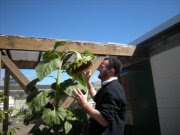He said that any kabbalah before his time was from tohu (chaos). He introduced concepts and terminology that changed the way kabbalah was understood.
It is amazing how little is known of him as a person. He only lived to the age of 38, and only in the last couple of years of his life did he move to Tzfat and begin to teach kabbalah. Everything we have from him is based on the transcriptions and books written by his main student R' Chaim Vital.
He was a younger contemporary of the Shulchan Aruch, who also changed the world, yet in very different ways.
Rabbi Isaac Luria (1534 – July 25, 1572) was a Jewish mystic in Safed. His name today is attached to all of the mystic thought in Safed: while his literary contribution to the Kabbalistic school of Safed was extremely minute (he only wrote a few poems), his fame led to the school and all its works being named after him. The main popularizer of his ideas was Hayim Vital, though Vital's claim to be the official interpreter of the Lurianic system was not undisputed.
Lurianic Kabbalah lost a certain amount of credit owing to its association with the false Messiah Shabbetai Tzvi: however it remained the leading school of mysticism in Judaism, and is an important influence on Hasidism. A minority of today's Jewish mystics belong to other branches of thought in Zoharic mysticism.
In Hebrew he is called Yitzhak Lurya יִצְחַק לוּרְיָא, Yitzhak Ben Shlomo Ashkenazi, and Yitzhak Ashkenazi. He is also known as Ari אֲרִי and He-Ari ("The Lion") from the acronym for Adoneinu Rabbeinu Itzhak ("Our Master Our Rabbi Yitzhak"), thus Arizal with "ZaL" being the acronym for Zikhrono Livrakha ("of blessed memory" or literally "let the memory of him be for a blessing"), a common Jewish honorific for the deceased, and known as Ari Ha-Kadosh ("Ari the Holy").
He was born at Jerusalem in 1534 to an Ashkenazi father and a Sephardic mother; died at Safed, Israel July 25, 1572 (5 Av 5332). While still a child he lost his father, and was brought up by his rich uncle Mordecai Francis, tax-farmer at Cairo, Egypt, who placed him under the best Jewish teachers. Luria showed himself a diligent student of rabbinical literature; and, under the guidance of Rabbi Bezalel Ashkenazi (best known as the author of Shittah Mekubetzet), he, while quite young, became proficient in that branch of Jewish learning.
At the age of fifteen he married his cousin, and, being amply provided for financially, was able to continue his studies. Though he initially may have pursued a career in business, he soon turned to asceticism and mysticism. About the age of twenty-two years old, he became engrossed in the study of the Zohar, a major work of the Kabbalah which had recently been printed for the first time, and adopted the life of a recluse. He retreated to the banks of the Nile, and for seven years secluded himself in an isolated cottage, giving himself up entirely to meditation. He visited his family only on the Shabbat, speaking very seldom, and always in Hebrew. Hassidim attribute to him that he had frequent interviews with the prophet Elijah through this ascetic life, by whom he was initiated into sublime doctrines.
[edit] Disciples
In 1569 Arizal moved to the Palestine; and after a short sojourn at Jerusalem, where his new kabalistic system seems to have met with little success, he settled in Safed. There he formed a circle of kabbalists to whom he imparted the doctrines by means of which he hoped to establish a new basis for the moral system of the world. To this circle belonged Rabbi Moses ben Jacob Cordovero, Rabbi Shlomo Alkabetz, Rabbi Joseph Caro, Rabbi Moses Alshech, Rabbi Eliyahu de Vidas, Rabbi Joseph Hagiz, Rabbi Elisha Galadoa, and Rabbi Moses Bassola. They met every Friday, and each confessed to another his sins. Soon Arizal had two classes of disciples: (1) novices, to whom he expounded the elementary Kabbalah, and (2) initiates, who became the depositaries of his secret teachings and his formulas of invocation and conjuration. The most renowned of the initiates was Rabbi Chaim Vital of Calabria, who, according to his master, possessed a soul which had not been soiled by Adam's sin. In his company Luria visited the grave of Rabbi Shimon bar Yochai and of other eminent teachers, it is said that these graves were unmarked -- the identity of each grave was unknown -- and through Elijah each grave was recognized. Arizal's kabbalistic circle gradually widened and became a separate congregation, in which his mystic doctrines were supreme, influencing all the religious ceremonies.
May His Soul Be Bound in the Bonds of Eternal Life

No comments:
Post a Comment